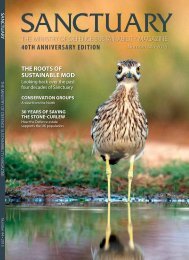SUSTAINABILITY
UC30G
UC30G
Create successful ePaper yourself
Turn your PDF publications into a flip-book with our unique Google optimized e-Paper software.
FEATURES<br />
Cooperation between Nations<br />
Conservation of the Senne Training Area<br />
The extensive heathland habitat on the Senne in bloom © Dr Gerhard Lakmann<br />
The Senne Training Area is a beautiful<br />
landscape of woodland and sandy<br />
heath with such a rich variety of<br />
species that it is considered to be one<br />
of the most important areas for nature<br />
conservation in northern Germany.<br />
The Senne was formed as a result<br />
of glacial action in the last two Ice<br />
Ages depositing huge quantities of<br />
low nutrient, acidic sand that was<br />
consequently modelled by wind<br />
and rain into inland dunes and brook<br />
valleys. This made for attractive<br />
countryside full of wildlife.<br />
Although human activity and livestock<br />
helped create a heathland, the poor<br />
quality of soil meant that the Senne<br />
was not particularly suitable for either<br />
settlement or farming, which was the<br />
main reason why the area was chosen<br />
for militar y training in 1892.<br />
At the end of World War II, the Senne<br />
Training Area was taken over from the<br />
Wehrmacht for ongoing military use<br />
by the British Army of the Rhine. In<br />
the mid-1950s, with the formation of<br />
the Bundeswehr, increasing numbers<br />
of troops were using the training<br />
area, which was expanded and reconfigured<br />
with new field-firing<br />
ranges, roads and infrastructure for<br />
tracked vehicles. Before this time, not<br />
much consideration was given to the<br />
protection of the environment, but<br />
concerns were beginning to arise about<br />
soil erosion, water quality and damage<br />
being caused to forests and heath.<br />
In the late 1950s, the Land<br />
Maintenance Team (LMT ) was formed<br />
with the principle aim of protec ting<br />
open areas of the training area<br />
from erosion and forest succession.<br />
Although the team were employees<br />
of the German Federal Government,<br />
they were funded and tasked by<br />
the British Forces, so this mark s<br />
the beginning of a co -operative<br />
relationship in estate management<br />
that persists to this day. In 1965, the<br />
LMT was joined by the Engineer<br />
The Pasque flower © Dr Gerhard Lakmann<br />
42<br />
Sanctuary 44 • 2015



